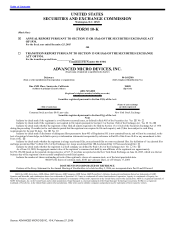AMD 2005 Annual Report Download - page 13
Download and view the complete annual report
Please find page 13 of the 2005 AMD annual report below. You can navigate through the pages in the report by either clicking on the pages listed below, or by using the keyword search tool below to find specific information within the annual report.
Table of Contents
embedded processors to address customer needs in non-PC markets where Internet connectivity and/or low power processing is a priority. Typically these
embedded processors are used in products that require high to moderate levels of performance where key features include reduced cost, mobility, low power and
small form factor. Products that use our embedded processors are targeted for specific market segments using SoC design techniques.
Our embedded microprocessor products consist of the AMD Geode™ family and the AMD Alchemy ™ family of products. AMD Geode microprocessors
are based on the x86 architecture and are optimized for high performance and low power. The Geode technology integrates complex functionality, such as
processing, system logic, graphics, and audio and video decompression onto one integrated device. We target our AMD Geode processors at each of the market
segments referenced above. With the AMD Geode family of microprocessors, we are able to extend the range of our x86-based product offerings to serve
markets from embedded appliances to high-end servers.
Our AMD Geode processors exemplify our “x86 Everywhere” strategy, which is our goal for utilizing the x86 instruction set architecture to power a wide
variety of devices in diverse places such as the home, office or car, in the supply chain, storage networks, and/or the data center. We believe that when a greater
number of devices are standardized upon an x86-based platform, end-users can benefit from the ability to run their existing x86-based software on devices that
interoperate with each other. This can accelerate and simplify the process of enabling faster, easier connectivity and data sharing between a wide range of
products, from portable consumer electronics to PCs and servers.
We developed our AMD Alchemy embedded processors for portable media players, Internet access points, and gateways in which low power consumption
is a key factor. All of these products have an architecture that provides a 32-bit MIPS instruction set. They support various Microsoft operating systems as well
as Linux, VxWorks, and other operating systems.
We believe our personal connectivity solutions offer our customers high performance at low power, faster time to market and lower product costs. Our
strategy is to continue providing cost-effective embedded microprocessors for personal connectivity devices that our customers can deploy quickly in their
applications.
Other
In October 2004, we launched the Personal Internet Communicator (PIC), a consumer Internet access device that we believe will help provide affordable
Internet access to first time technology users in high-growth markets. Through the PIC, end users are provided with access to a variety of communication and
productivity tools such as an Internet browser, e-mail, word processing, spreadsheet applications and a presentation viewer. The PIC runs on an operating system
powered by Microsoft Windows technology. The PIC is manufactured by third parties and is designed to be branded, marketed and sold by local service
providers such as telecommunications companies and government-sponsored communications programs. We supply the embedded microprocessors for the PIC.
We developed the PIC in support of our 50x15 initiative, which is our goal to deliver affordable, accessible Internet connectivity and computing capabilities to 50
percent of the world’s population by 2015. As of December 25, 2005, telecommunications companies and Internet service providers had introduced PIC products
in countries such as Brazil, the Caribbean, India, Mexico, Panama and Turkey. We report sales of PIC products under our “All Other” category.
Marketing and Sales
We sell our products through our direct sales force and through third-party distributors and independent sales representatives in both domestic and
international markets pursuant to non-exclusive agreements. Our agreements typically contain standard terms and conditions covering matters such as payment
terms, warranties and indemnities for issues specific to our products such as third-party claims that our products when used for their intended purpose(s) infringe
the U.S. patent rights or certain other intellectual property rights of a third
8
Source: ADVANCED MICRO DEVIC, 10-K, February 27, 2006
























